The California Nebula
20:10 29/10/2009 UTC
After a long cloudy and rainy period we finally got some nice weather (and moon of course). I had tuned my mount for few nights and had to shoot something to test it. California Nebula came in mind first, so it aimed at it. To proof my mount working as expected I did 15min subs and it worked fantastic. Too bad I forgot to switch dithering on. All in all, I got quite a nice set of data. Man, it is a HUGE object! Maybe I have to try to dig out some SII and OIII too for this.
NGC/IC Object List:
NGC1499 gaseous nebula RA:04h03m14.4 Dec:+36°21m'33" BMag: 5.0, LBN 756 California Nebula
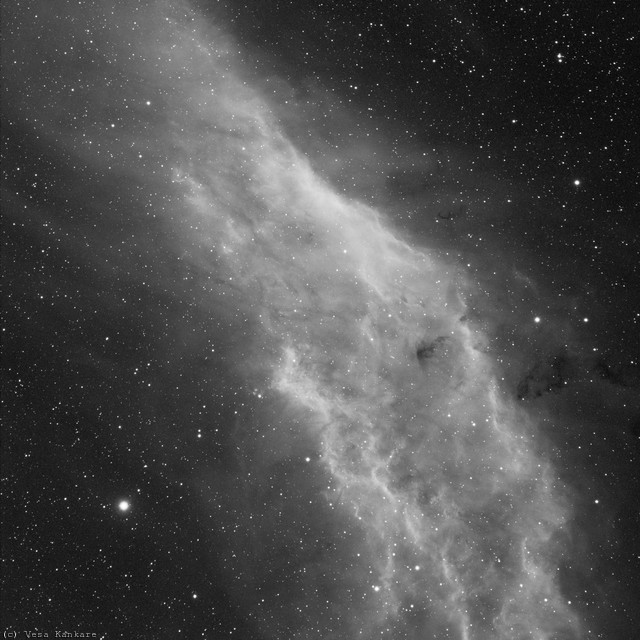
Camera: Atik Instruments 4000LE | Telescope: Skywatcher ED80 Pro 80mm f7.5 refractor, William Optics 0.8x focal reducer | Mount: Vixen GP-D2, Boxdoerfer PowerFlex MTS-3SLP drive controller | Filters: Baader H-alpha 7nm 2" | Guiding: The Imaging Source DMK 21AU04.AS CCD camera, Orion ShortTube 80mm f5 refractor, Stark-Labs PHD Guiding | Exposure: Ha 10x900s (2h30m) unbinned, CCD @ -30° f6 | Software: CCDWare CCDStack, Adobe Photoshop CS4, Stark-Labs Nebulosity 2 | Location: 60°31'N 26°52'E (Koivula/Kotka,FI) | Background sky brightness (SQM): 18.85 mag/arcsec² | Image Field: 1.808 x 1.812 degrees | Image Center: Ra 04h01m25s Dec +36°22'22" | Target altitude in the beginning of the exposure 48°
Learning image processing
07:18 23/10/2009 UTC
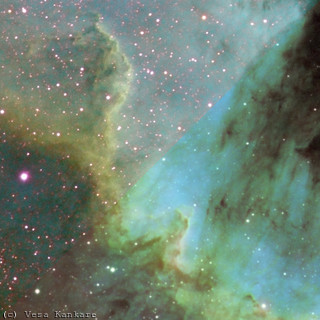
I first learned about a this new processing technique back in ATM meet in Artjärvi. J-P Metsävainio gave a very quick presentation on his Tone Mapping technique, which is very well suited for Narrowband work. While processing my Heart Nebula image I decided to give J-P's method a try. I instantly realised it potential and some pitfalls also. First, I learned there is nothing you can get to the image what already isn't there. So good SNR here is very essential, as always. As soon as you have a good raw data, the results are fantastic. The example image shown here has split in two, one side with my previous way of processing, the other using Tone Mapping. With this technique you get clean colors, good control over the color balance and the best: Absolutely zero purple halos around the bright stars! You can find a presentation of J-P's technique in his homepage .
Milky Way over Arezzo
19:02 17/9/2009 UTC
Greetings from Italy! I've always kept imaging Milky Way a difficult challenge. To get a perfect image, one needs a very dark and clear sky, sharp and fast optics and preferrably a nice scenery. I didn't have any tracking mount with me, but actually didn't even need one. Sky limit was easily reached with 20s subs due to quite heavy light pollution from the city of Arezzo. Clouds were passing by and also caused some bloats in the parts of the image. I have removed the brightly lit blurred trees from the front to make the image more pleasant to view. The best memory from this image is the conditions it was taken in. I was wearing no shoes nor socks and had only shorts and T-shirt on. Luxury we don't have here up north...
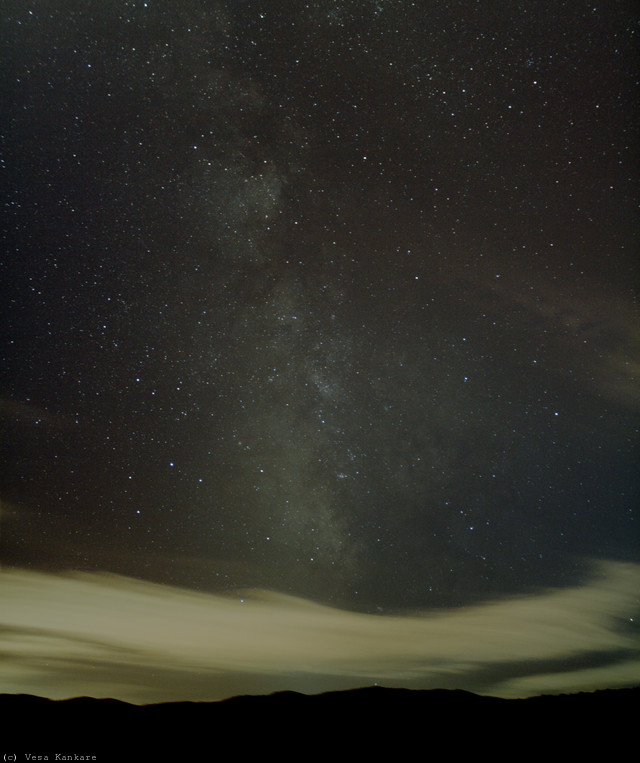
Camera: Canon EOS 1000D | Telescope: Canon EF-S 18-55mm zoom objective | Mount: Manfrotto photo tripod | Filters: - | Guiding: - | Exposure: 11x20s (3m40s) ISO1600 f3.5, @18mm | Software: Adobe Photoshop CS4, Stark-Labs Nebulosity 2 | Location: Arezzo, IT |
The Heart Nebula Project
18:55 7/9/2009 UTC
Finally I got some time and clear sky to do SII and OIII exposures to this. Moon was nearly full while shooting this so I got difficult gradient to my OIII frame. I also haven't done darks for the binned subs so this image is not properly calibrated yet. And on top of all this my ED80 lens was fogged due to low voltage cutoff in dew controller... I might have to shoot the OIII and SII once more to get decent signal to the image.
Update 20/10/2009: I reprocessed this image using a Tone Mapping technique by J-P Metsävainio. Now the channels have proper calibration frames also.
NGC/IC Object List:
NGC896 gaseous nebula RA:02h25m27.8 Dec:+62°01m'10" BMag: , SG 1.04
IC1805 open cluster RA:02h32m41.4 Dec:+61°27m'25" BMag: , OCL 352
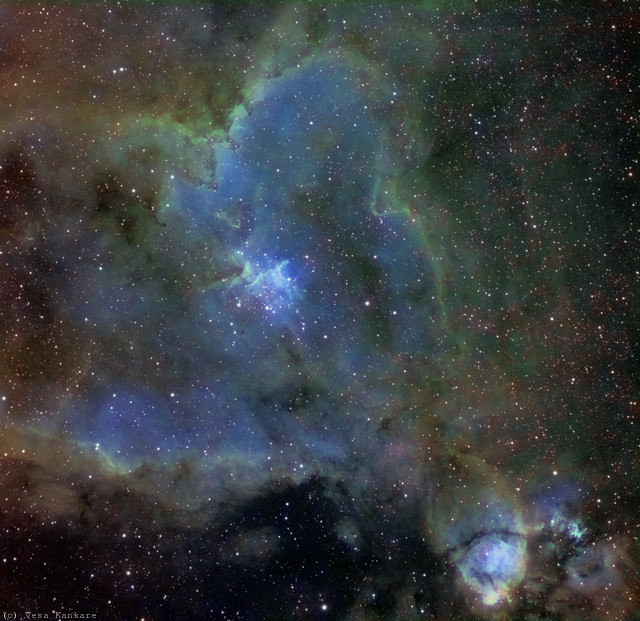
[High Resolution : 2006x1946 @ 3.18 arcsec/pixel]
Camera: Atik Instruments 4000LE | Telescope: Skywatcher ED80 Pro 80mm f7.5 refractor, William Optics 0.8x focal reducer | Mount: Vixen GP-D2, Boxdoerfer PowerFlex MTS-3SLP drive controller | Filters: Baader H-alpha 7nm 2", Baader SII 8nm 2", Baader OIII 8.5nm 2" | Guiding: The Imaging Source DMK 21AU04.AS CCD camera, Orion ShortTube 80mm f5 refractor, Stark-Labs PHD Guiding | Exposure: SII 6x600s (1h) 2x2 binned, dithered, CCD @ - 20°, OIII 6x600s (1h) 2x2 binned, dithered, CCD @ - 20° Ha 13x900s (3h15m) unbinned, dithered, CCD @ -20° f6, | Software: CCDWare CCDStack, Adobe Photoshop CS4, Stark-Labs Nebulosity 2 | Location: 60°31'N 26°52'E (Koivula/Kotka,FI) | Image Field: 1.774 x 1.723 degrees | Image Center: Ra 02h32m34s Dec +61°36'06" | Target altitude in the beginning of the exposure 47°
Star Trails Around Pole
20:10 24/8/2009 UTC
I've always wanted to take these star trail images, but for some reason I haven't done so during these years. This time I pondered around while my CCD setup was doing Heart Nebula and suddenly remembered star trails. I went inside, grabbed my trusty EOS 1000D, put it into tripod and set the timer remote to do 2 minute exposures. Easy and fun. Quite the opposite of narrowband work... (Don't get me wrong, NB is fun, but far from easy)
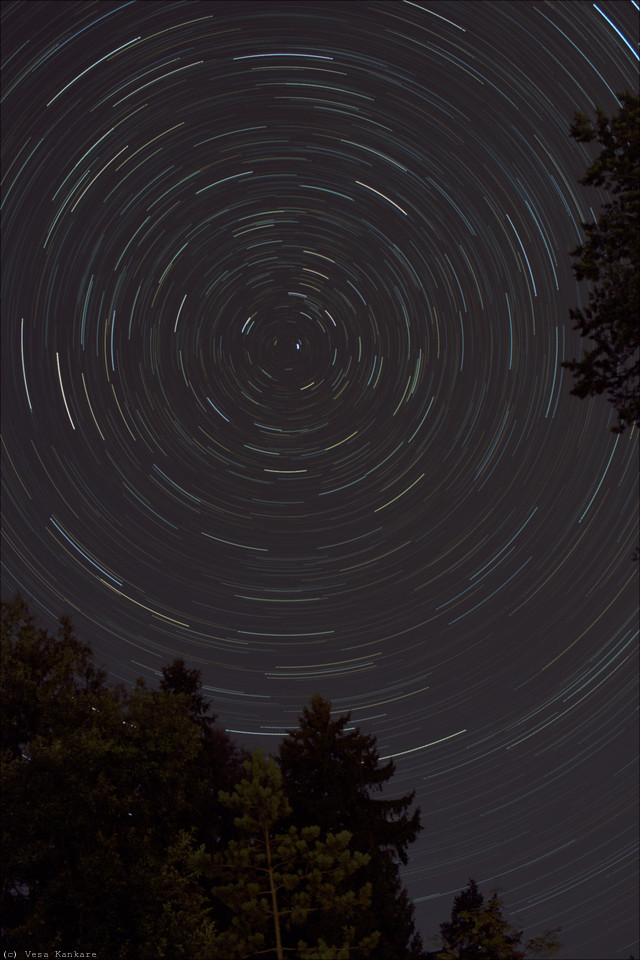
Camera: Canon EOS 1000D | Telescope: Canon EF-S 18-55mm zoom objective | Mount: Manfrotto photo tripod | Filters: - | Guiding: - | Exposure: 38x120s (1h16m) ISO800 f4.5 @18mm | Software: IRIS, CCDWare CCDStack, Adobe Photoshop CS4 | Location: 60°31'N 26°52'E (Koivula/Kotka,FI) | Background sky brightness (SQM): 20.11 mag/arcsec² |